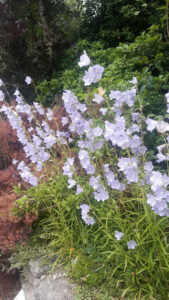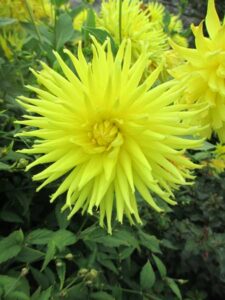Gardening
with Charlie Wilkins
THE ARRIVAL OF FOG
Last night there were patches of fog in the open fields high above Villa Marie, and massed mists moved across the sleeping garden. From the top of Barnavara Hill, ghostly scenes drifted about in the valley of Riverstown, dissecting the trees, houses and shopping centre. It imposed a dripping silence in an area that is normally a pleasant, Glashaboy riverside walk. From the top of the hill the fog seemed to float like rivers of white, flowing and moving and spilling into every crevasse, gully, and dip. Alfred Hitchcock would have treasured the scene!
In the garden, the fog had crept in silently, adding it would seem, yet another eerie touch of atmosphere and mystery. Consisting of tiny water droplets suspended in the atmosphere, it obscures and restricts visibility Many people think of fog as being white, but in reality it can pick up a grey, blue, orange or even reddish cast. Much depends on the background plants and their colouring. Depth and form are reduced at best, and lost completely when the moisture content increases. Colours too quickly become muted adding to the confusion and bewilderment.
Primarily due to the cooling of the land by radiation, fog is formed during spells of calm, settled weather with clear skies. The air becomes chilled to dew-point on contact with the ground, and the condensed vapour then becomes visible as the fog we recognize. The whole process can often be watched on calm evenings, when the cooled air with its white mists flows slowly down sloping ground to pool and stagnate at the lowest level. As the night advances the white expanse of ‘sea’ becomes deeper and deeper until the depressions and valleys resemble estuaries with long branching tributaries.
I have often moved about the garden to experience firsthand the eerie movement of fog. Its swirling mists and clinging dampness are first to envelop my person and everything within sight. Great waves of vapour then move ghost-like, condensing not alone on my clothing but the leathery leaves of fattening camellias. It coats the last remaining webs of the Orb spider with myriads of jewel-like water droplets. I can usually taste its dampness, feel its clinging shroud on my skin, and smell its strange perfume. Recently, whilst experiencing its eerie movement, a sudden darkness began to creep in, adding to its denseness. The combination suggested I should move indoors. When thick fog makes friends with the dark it’s no time to linger: better to move inside and latch the door. The bright fire and lights beckon.

CHILDREN AND GARDENS
To a child, any garden is a place of strange marvels. It need not be huge, but it should be vivid, with plenty of foliage to create hides, then pathways to hidden areas, and yet more exciting dark places. It should have extraordinary smells, peculiar textures, and wonderful surprises. Unusual objects and strange growths will make them pause in their exploration and these will lead to queries and questions. The appearance of fungal growths at the base of an old tree will certainly cause them to ponder their origin and purpose. Just as engaging will be the jewel-like raindrops that gather on the leaves of Lady’s mantle, or the elaborate and intricate tangle of cobwebs which stretch from shrub to shrub. They will assume that fairies live among the pile of leaves at the bottom of the garden, convince themselves that popping fuchsias will grant their most secret wish, yet doubt that Granny’s Bonnets (Aquilegias) were ever really worn by their grannies. In short, they like the mystery and adventure a garden offers, the thrill of the unknown, and even perhaps, the appeal of long forgotten, old-fashioned flowers.
And yet, old fashioned plants (of which there are many) are still in demand today. Most were said to grow best for the working classes in the days when these were distinguishable. They were supposed to sulk in the gardens of the lady of the manor, who had oodles of time to spare and thrive for those who laboured raising families on the tiniest plots of land. Nowadays, these social categories have thankfully been equated and mixed together, and through the dust, we probably see the real truth about many old fashioned plants.
We, Frances and I, have been blessed with fifteen grandchildren and in the garden they ponder the strange and quite amazing blooms on the Arum lily (Saint Joseph’s lily). These strange looking lilies fascinate them even more than the collection of fuchsia. They stare wide-eyed at their massive, mufti-flowered clumps, their luxuriance of foliage, and thick, tall stems bearing brilliant white, sheath-like flowers with inner cones of stiff, yellow spadices. What were these for they wonder?
Whichever reasoning they arrive at, run with it and encourage further investigation. Try always to promote their gardening interests and if possible, give them their own little outside space in which to experiment. Take them on garden visits, and show them wild flowers and ornamental oddities as often as possible. Talk about nature and the history of where they are living. Soon enough time will rob them of their youth but they will thank you for the grounding you gave them all the days of their life.
SNAKE’S HEADS IN THE GARDEN?
Fritillaries are quite a classy lot, and one of the most exquisite things you could grow in the spring garden. So, if you have a damp spot somewhere and you’re wondering just what to put there, there’s still time to indulge in a dozen of snake’s-head fritillary; Fritillaria meleagris. Their foot high stems sport blooms which are elegant and bell-like, regularly marked in chessboard squares, some with tones of light and dark purple, or now and again, green and white markings. All, I assure you are simply delicious. They require soil which does not dry out too much in summer and dappled shade if possible. The bulbs are made up of fleshy scales and must not be allowed to dry out, or be handled roughly. Plant them five inches deep. If you can enrich the ground with some compost or rotted manure then all the better.







